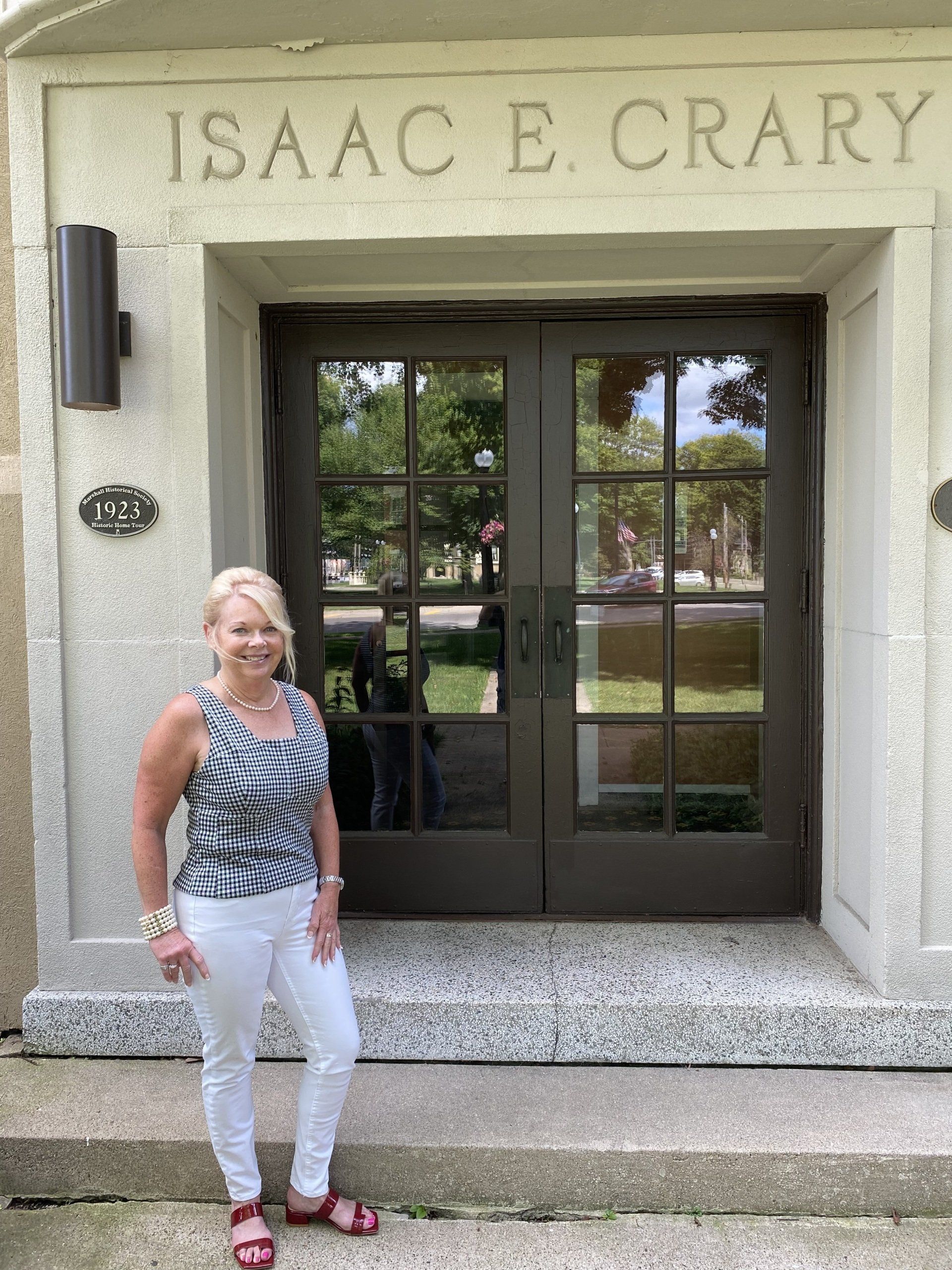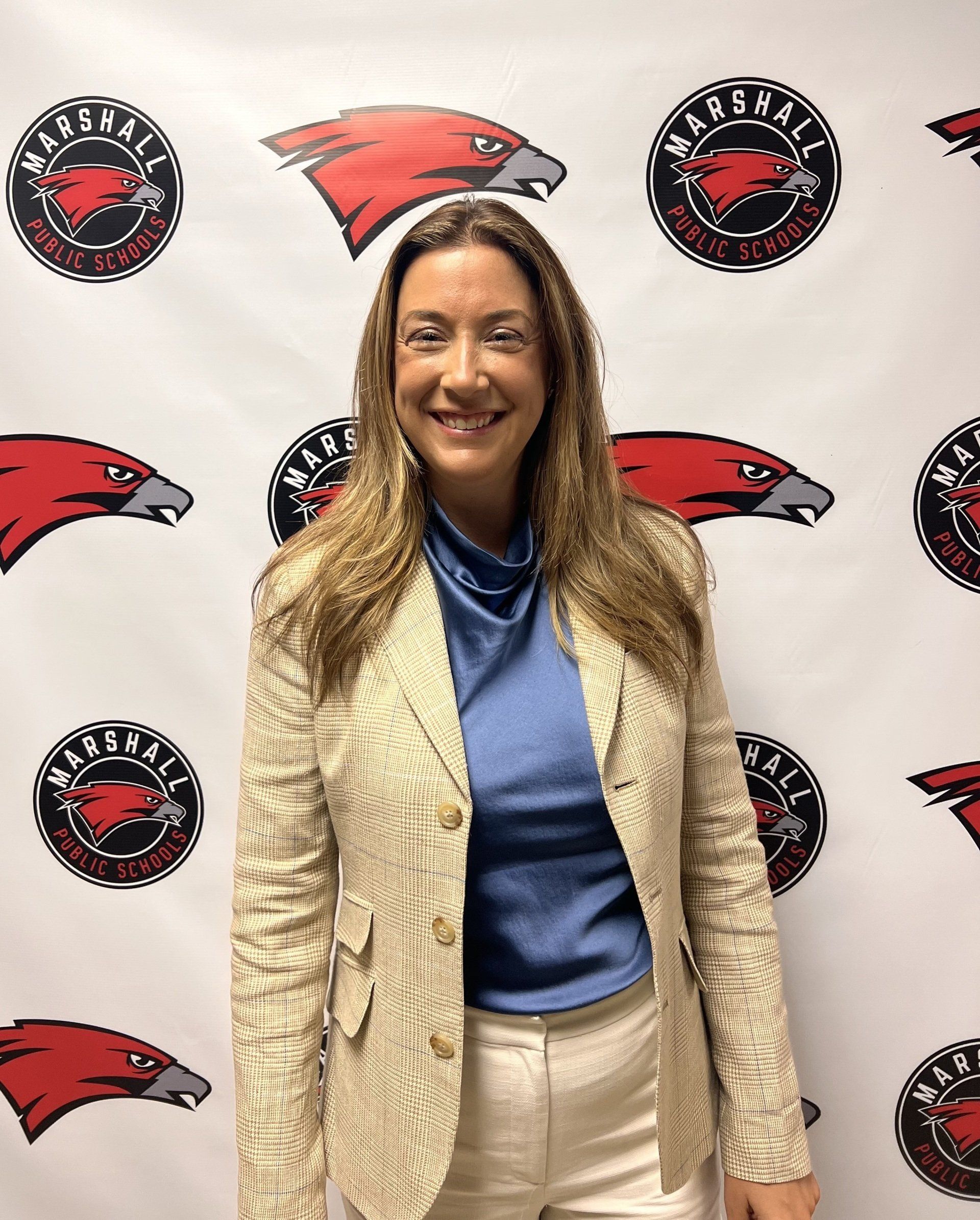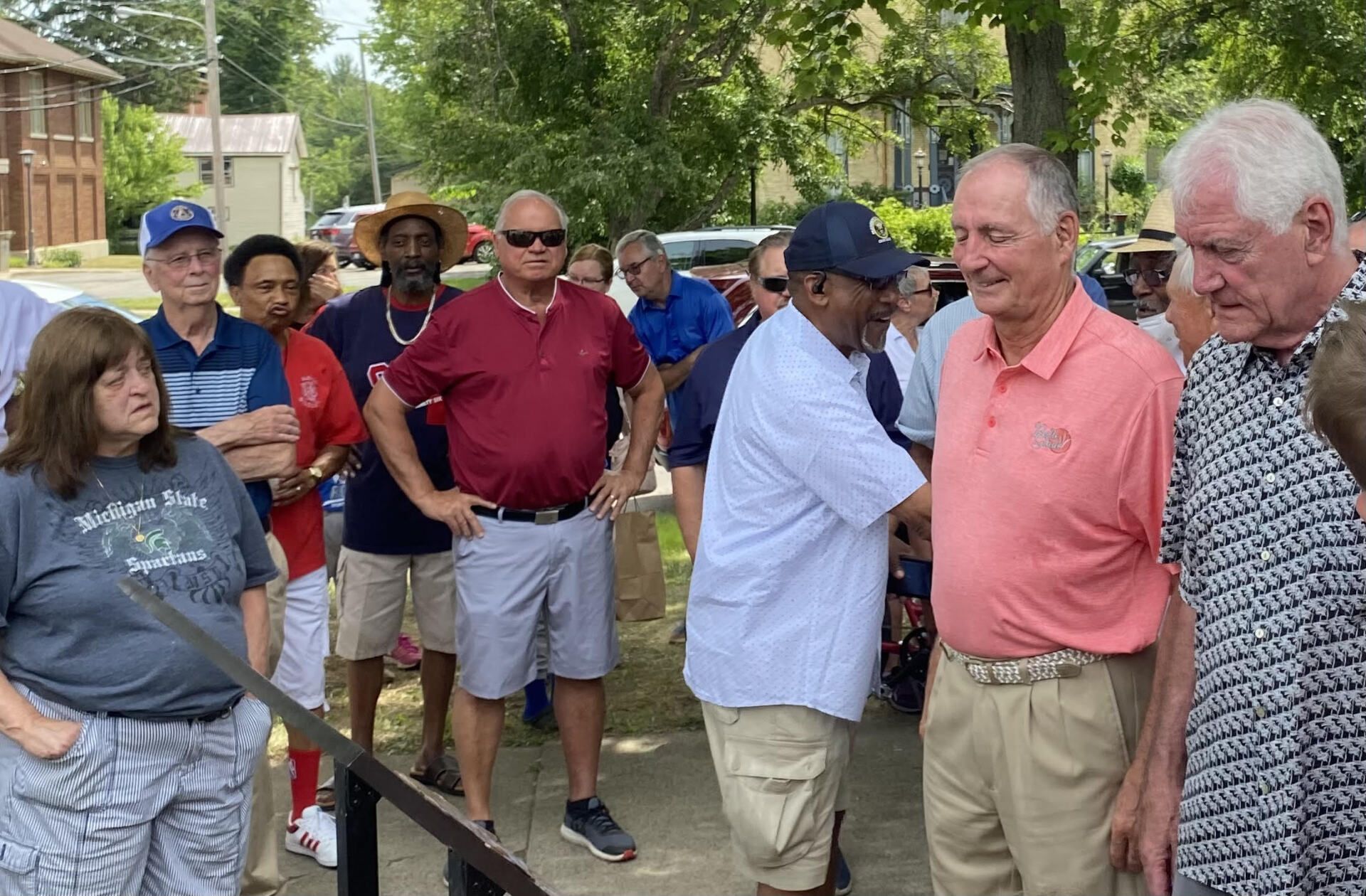Marshall resident and former MSU cross country co-captain honored during football game at Spartan Stadium
Seth Berry • November 24, 2021
On Nov. 13, Michigan State University honored the 1968, 1970 and 1971 cross country Big Ten Championship teams during the football game against Maryland at Spartan Stadium.
Marshall resident Chuck Starkey played an integral part in the success of the ‘68 and ‘70 teams and was a co-captain of the 1970 team during his senior year along with teammate Kim Hartman.
On Nov. 12, members of the teams got together for a dinner in East Lansing at the Spartan Hall of Fame Cafe before being honored at the game the next day while being able to watch the 40-21 Spartan victory in the sky box.
Starkey said the experience was something he won’t ever forget and that it was fun being able to catch up with some former teammates while also being able to meet some members of the current cross-country team at MSU.
“It was overwhelming, actually—it was so cool,” said Chuck. “It was amazing for me to be there with those three trophies and with all the guys that were there. Two of my favorite guys that I really got along with, they were there (Randy Kilpatrick and Ken Popejoy), so that was neat.”
Chuck has been married to Helen for nearly 15 years and Helen has lived in Marshall for 32 years. Their first date took place at Schuler’s in downtown Marshall. When their anniversary comes around each year Dec. 9, they usually go to Schuler’s to celebrate.
Helen took the trip with Chuck to East Lansing to support him in the celebration and was happy for the support Chuck and the other team members received.
“Everyone said (at the dinner on Nov. 12) how encouraging he (Chuck) was,” Helen said. “I don’t think people realize what a grueling sport running is. It takes a lot of endurance.”
Chuck’s journey as a runner began in junior high in Columbus, Ohio where Chuck grew up. At Columbus West High School, Chuck ended up becoming a three-time state champion (two in cross country, one in track). But when Chuck first got to high school, he went out for the football team and got cut, which ended up being a good thing for him.
“All these guys went out for the football team, and I had never played one second of football,” Chuck said. “And I got out there and made a total fool of myself and got cut on the first round. That actually was a good thing that they did that, because then I figured ‘I’ve got to do something’ then ran on the (cross country) team and that’s when I won my first state championship.”
Chuck said there were about a dozen schools who recruited him during high school before selecting MSU and going there on a full ride scholarship while eventually getting a Bachelor of Fine Arts degree from the school.
Jim Gibbard was the head coach while Chuck ran at MSU while Jim Bibbs was his assistant. Rufus Glass was Chuck’s high school coach. Throughout his running career, Chuck said all of these coaches helped push him and teach him lessons that he would carry with him years later.
“My coach in high school was very good about giving advice, he was a tremendous coach,” Chuck said. “I really started to know about pace from him because he would say ‘don’t burn all your energy in the first 100 yards, even it out.’ So, I learned about pace then. Gibb (Gibbard) was a good coach too, but he was tough, very tough on everybody.”
As tough as coach Gibbard could be, Chuck liked to keep things loose as a co-captain to ease some tension and keep the team relaxed.
“The one thing that I thought was nice about the dinner Friday (Nov. 12) was that Ken (Popejoy) said something nice about all the teammates that were there,” Helen said. “And what he said about (Chuck) was as a co-captain, as difficult as the coach (at MSU) could be, you (Chuck) being a co-captain made it fun.”
Chuck said the team in college would run 20 miles a day, with the first 10 miles of the run being lighter at an eight-minute pace, while the team would do interval work in the afternoon to cover the rest of the mileage.
He remembers one home race where he suffered an injury about two miles into a five-mile race but still ended up finishing. After the race was over, Chuck said he found out he ran three of the five miles on a broken leg.
“It was a five-mile race, and I was about in the third spot at the time - there were 17 guys in the race,” Chuck said. “Right when I got to where the big hill was, I felt something, a really horrendous pain. I thought ‘Well, just keep running and it’ll work itself out.’ Well, I got to the finish line, and it just seized up, my whole calf area. Out of 17 guys, I beat three of them with a broken leg. And you could imagine what kind of razzing (the ones who finished behind him received). It happened about the two-mile mark, so I ran three of them on a busted leg.”
After college, Chuck continued running as a hobby and participated in many events, most notably the Boston Marathon in 1996 and the San Francisco Marathon after that.
For competitive runners, being able to qualify for those races is considered a great accomplishment. Chuck said his experiences at the two races were satisfying and memorable.
“I always felt that if you consider yourself to be a distance runner, you should run east coast and west coast,” said Chuck. “So, I ran Boston and San Francisco. It was really cold at Boston and San Francisco was like one big hill. It seemed like I just ran uphill for 26 miles.”
Now with Parkinson’s disease, Chuck can no longer physically go on runs, but keeps a positive mindset and encourages other runners to aim to reach their goals.
Chuck told one story about his daughter when she told him she would never be able to run a marathon. But as Chuck has always done, he encouraged her and surely enough, she completed the run.
“I said, ‘look, it’s 90% mental and 10% training—so if you get a good attitude (you’ll be able to do it),’” Chuck said. “And she did. She completed her one and only marathon, the Cherry Festival in Traverse City.”

Get to know MPS Superintendent Becky Jones as she looks ahead to the new school year Marshall Public Schools Superintendent Becky Jones said she has always had a passion for wanting to work in education. Even though her master’s degree is in business from Spring Arbor University, Jones originally went to school at Eastern Michigan University to be a special education teacher when she was an undergraduate before making the switch to the business field. “I always wanted to work in some sort of line in education and be a part of the school system,” Jones said. “My aunt was a special education teacher in an early childhood role and she worked for Jackson ISD. That was part of the reason why I wanted to go to school to be a special education teacher when I started. I ended up changing and I’m not 100% sure why I changed, but it’s interesting that I ended up into the system in the career path of doing that.” After Jones graduated from EMU, she landed a job in Jackson as a business manager for a construction company before being hired at Jackson County Intermediate School District in business operations. Jones has been in the school system ever since her time at Jackson County ISD before coming over to Marshall Public Schools, where she served as the director of business operations for the district for eight years. Jones said the relationships she built over the eight years in that role has helped her transition into the superintendent role. “I think with how I am as a leader and how I am as a person, I like to build a lot of personal relationships,” said Jones. “So I think that’s just something that has come natural for me over the eight years, I’ve just always built really good relationships with the people that I work with. I care about the people, I care about families, I care about our students. It didn’t seem unnatural for me to fill into the role of interim, because it was something I wanted to do.” Jones was appointed interim superintendent in May 2021 after the departure of former Superintendent Randy Davis. After eight months, the Marshall Public Schools Board of Education unanimously agreed to hire Jones into the permanent role. When reflecting on when she officially was hired into the permanent role, Jones commended the many who have supported her during the process and said she feels honored to now be serving in the role. “I think that educating people’s children and educating our youth is a very important role,” said Jones. “It’s an honor and a blessing in how I look at it.” Jones added that she is driven and inspired by being able to serve two communities, being students and families in both Marshall and Albion. “When I look at the district as a whole, I look at it as serving two communities,” Jones said. “Obviously we have an interesting history as a school system with bringing Albion into the system and serving both Albion and Marshall. That to me alone, just having the two communities that we get to serve, is a wonderful thing. Both communities have a lot to offer when you look at it. There are a lot of great people, leaders and businesses that are really supportive of the school system and really supportive of our kids. That’s one of the many benefits of this role.” Jones added she is also inspired by being able to serve the students as a whole and being able to interact with them and the teachers who are involved in their learning development. “Also the kids and the interaction with the kids. We get to go out to buildings and interact with the kids and interact with the teachers,” Jones added. “We have a wonderful staff in the district. When I look at the role, I don’t look at it as a superintendent role, I look at it as ‘I get to work with these amazing people who work for Marshall Public Schools and I get to meet all of these wonderful community members.’” In a March article from the Battle Creek Enquirer, former Board President Richard Lindsey acknowledged Jones played a key role in the annexation of the Albion School District and Marshall Public Schools in 2016. Jones further explained how she was involved in that process. “I walked alongside Dr. Davis when annexation happened,” she said. “I sat in all the meetings, went through all the financials and worked on all those things and what it would look like. So I was right alongside working through the annexation piece of it. Through annexation, there were a lot of people that care about both communities and about wanting to make sure that all of our kids have equal opportunity and equal access to good education. To me, in my eyes, that’s the one thing that matters, is equal access to kids for education.” As superintendent, there are both challenges ahead for Jones along with some things that she is excited about in terms of plans the district is implementing going into the school year. “I’m really excited about our strategic plan,” Jones said. “I think it’s really important for organizations to have a vision for what they are working towards. And I think that we’ve clearly written out what our vision is as an organization. I’m really looking forward to putting that in place.” As far as challenges go, Jones brought up being able to educate students in a post-pandemic world and focusing on providing support for students and families on what they need to further their education in light of all the disruptions that took place in schools during the past two years. “I think we still have a lot of challenges post pandemic when we’re looking at children and we’re looking at education,” Jones said. “We as a district need to sit down and focus on where our kids are at and where we need our kids to be in terms of education. So, I think for this year it’s really going to be a huge focus on what support we can give our families and the things we can do to really get our kids educated and where they need to be in a post pandemic world.” Another challenge in Jones’ eyes is how to put a new bond on the table and how to get community members to support one this time around. Last November, a $45.6 million bond was voted down by a 2 to 1 margin. She also mentioned the school’s sinking fund millage that she said will be on the ballot for voters this November. “We have $75 million worth of needs,” said Jones. “We obviously had a failed bond attempt and those needs haven’t gone away. So we’re going to have to go back out to the community in looking at a bond and (figure out) what we need to do. We need to sit down and talk about where we’re at with that. Another thing is with our sinking fund millage. That is set to expire and we’re going to be putting a renewal on the November ballot. It is a renewal but it’s not going to be worded as a renewal, because we’re going to add in security and technology services for that. So we’re really going to have to get out there and communicate effectively with the communities about that.” When Jones’ time is done at MPS, whenever that may be, she said she just hopes for both communities to look at the school district and be proud of what it represents. “I want both communities to be proud of their school system,” she said. “I want Marshall Public Schools serving both Marshall and Albion communities and for it to be a choice district for those communities. I want them to be proud of the work we do here and how we educate their kids.”

Get to know MPS Superintendent Becky Jones as she looks ahead to the new school year Marshall Public Schools Superintendent Becky Jones said she has always had a passion for wanting to work in education. Even though her master’s degree is in business from Spring Arbor University, Jones originally went to school at Eastern Michigan University to be a special education teacher when she was an undergraduate before making the switch to the business field. “I always wanted to work in some sort of line in education and be a part of the school system,” Jones said. “My aunt was a special education teacher in an early childhood role and she worked for Jackson ISD. That was part of the reason why I wanted to go to school to be a special education teacher when I started. I ended up changing and I’m not 100% sure why I changed, but it’s interesting that I ended up into the system in the career path of doing that.” After Jones graduated from EMU, she landed a job in Jackson as a business manager for a construction company before being hired at Jackson County Intermediate School District in business operations. Jones has been in the school system ever since her time at Jackson County ISD before coming over to Marshall Public Schools, where she served as the director of business operations for the district for eight years. Jones said the relationships she built over the eight years in that role has helped her transition into the superintendent role. “I think with how I am as a leader and how I am as a person, I like to build a lot of personal relationships,” said Jones. “So I think that’s just something that has come natural for me over the eight years, I’ve just always built really good relationships with the people that I work with. I care about the people, I care about families, I care about our students. It didn’t seem unnatural for me to fill into the role of interim, because it was something I wanted to do.” Jones was appointed interim superintendent in May 2021 after the departure of former Superintendent Randy Davis. After eight months, the Marshall Public Schools Board of Education unanimously agreed to hire Jones into the permanent role. When reflecting on when she officially was hired into the permanent role, Jones commended the many who have supported her during the process and said she feels honored to now be serving in the role. “I think that educating people’s children and educating our youth is a very important role,” said Jones. “It’s an honor and a blessing in how I look at it.” Jones added that she is driven and inspired by being able to serve two communities, being students and families in both Marshall and Albion. “When I look at the district as a whole, I look at it as serving two communities,” Jones said. “Obviously we have an interesting history as a school system with bringing Albion into the system and serving both Albion and Marshall. That to me alone, just having the two communities that we get to serve, is a wonderful thing. Both communities have a lot to offer when you look at it. There are a lot of great people, leaders and businesses that are really supportive of the school system and really supportive of our kids. That’s one of the many benefits of this role.” Jones added she is also inspired by being able to serve the students as a whole and being able to interact with them and the teachers who are involved in their learning development. “Also the kids and the interaction with the kids. We get to go out to buildings and interact with the kids and interact with the teachers,” Jones added. “We have a wonderful staff in the district. When I look at the role, I don’t look at it as a superintendent role, I look at it as ‘I get to work with these amazing people who work for Marshall Public Schools and I get to meet all of these wonderful community members.’” In a March article from the Battle Creek Enquirer, former Board President Richard Lindsey acknowledged Jones played a key role in the annexation of the Albion School District and Marshall Public Schools in 2016. Jones further explained how she was involved in that process. “I walked alongside Dr. Davis when annexation happened,” she said. “I sat in all the meetings, went through all the financials and worked on all those things and what it would look like. So I was right alongside working through the annexation piece of it. Through annexation, there were a lot of people that care about both communities and about wanting to make sure that all of our kids have equal opportunity and equal access to good education. To me, in my eyes, that’s the one thing that matters, is equal access to kids for education.” As superintendent, there are both challenges ahead for Jones along with some things that she is excited about in terms of plans the district is implementing going into the school year. “I’m really excited about our strategic plan,” Jones said. “I think it’s really important for organizations to have a vision for what they are working towards. And I think that we’ve clearly written out what our vision is as an organization. I’m really looking forward to putting that in place.” As far as challenges go, Jones brought up being able to educate students in a post-pandemic world and focusing on providing support for students and families on what they need to further their education in light of all the disruptions that took place in schools during the past two years. “I think we still have a lot of challenges post pandemic when we’re looking at children and we’re looking at education,” Jones said. “We as a district need to sit down and focus on where our kids are at and where we need our kids to be in terms of education. So, I think for this year it’s really going to be a huge focus on what support we can give our families and the things we can do to really get our kids educated and where they need to be in a post pandemic world.” Another challenge in Jones’ eyes is how to put a new bond on the table and how to get community members to support one this time around. Last November, a $45.6 million bond was voted down by a 2 to 1 margin. She also mentioned the school’s sinking fund millage that she said will be on the ballot for voters this November. “We have $75 million worth of needs,” said Jones. “We obviously had a failed bond attempt and those needs haven’t gone away. So we’re going to have to go back out to the community in looking at a bond and (figure out) what we need to do. We need to sit down and talk about where we’re at with that. Another thing is with our sinking fund millage. That is set to expire and we’re going to be putting a renewal on the November ballot. It is a renewal but it’s not going to be worded as a renewal, because we’re going to add in security and technology services for that. So we’re really going to have to get out there and communicate effectively with the communities about that.” When Jones’ time is done at MPS, whenever that may be, she said she just hopes for both communities to look at the school district and be proud of what it represents. “I want both communities to be proud of their school system,” she said. “I want Marshall Public Schools serving both Marshall and Albion communities and for it to be a choice district for those communities. I want them to be proud of the work we do here and how we educate their kids.”

In February of 1921, while what would eventually become the Marshall Country Club was being organized, 70 acres on the south shore of Lyon Lake was purchased for the golf course. That summer was spent by members raking stones, tearing down fences and leveling off and cleaning land while Harold C. Brooks, the club’s first president, hired golf architect Tom Bendelow of Chicago to help design the course. The following year, Brooks erected the club house that was planned by his architect friend Howard Young of Kalamazoo. A breezeway connected the club house with a pro shop and the country club was up and running. There have been a few changes made to Marshall Country Club over time, including the course being renovated into an 18-hole course from a nine-hole course in 1972. But 100 years later, the country club is still serving area golfers, with numerous events on tap as MCC celebrates its centennial year. Director of Communications Nancy Card said she believes Marshall Country Club’s ability to adapt over time has allowed the golf course to stay open even during ever-changing times. “It (country clubs) used to be much more formal,” said Card. “It used to be the ‘good ol' boys club.’ It used to be a high stakes kind of a thing. And now, through the evolution of all of these years, it’s interesting to me to see how creative we’ve had to become in order to continue to operate in the new world. It’s so different and we can’t operate like we used to back then. Just watching the changes and the evolution and how things have made us who we are today, that’s very important. And it’s so exciting to see how people are consumed with this. They really love our country club.” According to a 2019 article from Business Insider , country club memberships dropped 20% from 1990 to 2014. The number of clubs are also diminishing, as there were over 5,000 member-owned full-service golf and country clubs in the U.S., according to the article. By 2017, that number had fallen to about 3,900. MCC used to be a strictly private country club, but over time has morphed into a quasi-private, quasi-public course, with a restaurant, Lyon Lake Grill, that is open to the public. Feef Dillon, a member of the centennial celebration committee, said offering a warm environment has been one of the main keys to making the country club a successful operation. “I think we have to have a welcoming environment that welcomes all walks of life,” said Dillon. “Female, low and high income, we have to make it affordable for people to want to be here and make it worth their while and offer activities that are appealing to people. Long gone are the days where you could write off your country club membership. It used to be that companies would foot the bill. That’s no longer the case. Now we have to find ways (to gain members) and the relationships make it happen.” Tom Duffey, an MCC Board member and past club president, added it’s not only the friendships that are created, but the community environment that has made the country club a special place for him and many others. “This is a great place for family activities,” Duffey said. “We have both Marshall golf teams here, Homer golf teams, Albion College, Olivet College. I brought my kids out to play and now I’m bringing my grandkids out to play. It’s just a friendly, nice place to bring kids. You’ll see a bunch of kids out here hitting balls. It’s just a nice place to come out to.” The COVID-19 pandemic brought tough times to many businesses across the country, and MCC was no exception. House Manager Sarah Coco has been at MCC for four years and said while there have been some difficult times to get through, she did not ever want to leave because of her passion for the country club and seeing how much it matters to so many people she interacts with. “This is my first time working at a country club and it is different than any other restaurant, bar or hospitality place that I’ve ever worked at,” said Coco. “It was pretty challenging during COVID in that situation to get creative with how to be open, how to serve the members. It was a struggle, a huge struggle. You kind of step back and think ‘why am I doing this? You could go anywhere right now and get a job.’ But for me, I can’t do that because this place just means so much to so many people that it becomes special to you.” Vicki Knickerbocker, another member of the centennial celebration committee and MCC member said the country club is special to her in many ways, from building friendships to simply giving her and her husband a hobby. “I think it’s very important for both myself and my husband because it gives us something to do,” Knickerbocker said. “We could be working in our yard or doing something (else), but we’re outside and it’s beautiful out here. My husband is out here (frequently). I’m here maybe a couple days a week, but if it wasn't here where (would we be)?” To date, MCC has held monthly celebrations to honor its centennial year. On Aug. 13, two golf tournaments and a dinner will be held at the country club. The first tournament of the day is for current and past members only and will begin at 8:30 a.m., while the second tournament—a four-person scramble, is open to anyone and is set for an approximate 1:30 p.m. start time. Both tournaments have limited spots available. The centennial dinner is open to the public and tickets are currently on sale. Anyone interested in purchasing tickets can contact MCC. There will also be a raffle drawing that event organizers hope will be held that night, where ticket holders will have a chance to win a variety of prizes, with the top prize being a free membership to the country club. MCC will conclude its celebrations on Oct. 1 with “100 years of fun” and standup comedian Dave Dyer, an event that will also be open to the public. “We want people to know that we are celebrating, why we are celebrating and that we invite them to come and celebrate with us,” Card said.

Jerry Sacharski was a recreation league director in Albion who pioneered T-ball as an organized youth sport in 1956 because he couldn’t stand to turn away young children with the desire to play baseball. Sacharski passed away in February of 2009, but his memory has lived on, which was apparent on June 25 when well over 100 community members came together at Tee-Ball Garden in Albion, where a new T-ball statue and historic plaque was unveiled under the leadership of the Restore Our Coke Sign: Bring Art and History Downtown campaign team. Many of Sacharski’s former players and their families were present to celebrate the event, along with members of the Sacharski family, including Jerry’s three sons—David, Michael and William. Following the ceremony, current T-ball players played a short game in Victory Park near Hannah Street, which was followed by an “Old-Timers” game. John Sims, one of Sacharski’s former players who spoke at the ceremony, expressed appreciation for his former coach and the impact he left on him and many others who played for him growing up. “I go down to that field and I can see him (Sacharski),” Sims said. “I think everyone who played “pee-wee” ball with him remembers him. We have very few people in our lives as young people who make a mark like that. I’m 70 years old and I still remember that guy with very great kindness. He was good to us.” Sims also cited a 1960 T-ball exhibition game, when Sacharski took him and other pee wee players to Michigan State University to put the sport on display in front of a TV audience as the game was videotaped by a local television station. In 2000, the video was accepted into the National Baseball Hall of Fame at Cooperstown, N.Y. Sacharski was also a teacher with Albion Public Schools for nearly three decades. His son David said his father was great at teaching the fundamentals of the game and brought his teaching qualities to the baseball field. “My dad wanted the kids to learn the fundamentals of baseball while playing T-ball, which was sometimes called pee wee ball,” said David. “Notice the word ‘fun’ in fundamentals. He wanted the kids to have fun and at the same time, learn basic skills. Being a teacher, he made T-ball a classroom activity on grass.” William, another of the three Sacharski sons, said he was one of the original 60 T-ball players in Albion. He remembers the summer of 1956 when “everything changed” in terms of how the game of baseball was played when he was a young boy. “The whole game that we played changed,” said William. “As a 7-year-old kid, we actually got to go up to bat and we actually got to hit the ball (instead of getting walked or striking out). You could take a stance and that ball was sitting there on the tee and you could just kind of drive through it. There were no free passes, there were no strikeouts. Every play, something happened. Just like Dave said, after a while, your fundamentals and your skills (improve) because you’re not standing around.” Michael is the oldest of the Sacharski boys and said he was an umpire during the first T-ball game in June of 1956. He thanked everyone who showed up to the event and commended all who helped his father make the sport successful. He told a story about his father after Jerry retired from school teaching when he was in Hawaii that embodied the type of person and coach Jerry was. “I think the second spring he was there, he ambled up to the park that was near our home, because they were staying in our home,” Michael said. “And he ambled up in the park, and in Hawaii they have springtime youth baseball. He was sitting around on a picnic table watching how teams were practicing on the various fields and he did that a few times. Finally, one of the coaches of one of the teams—the players would have been T-ball players here, but they had (the pitcher) throw the ball, they don’t hit it off the tee—the coach said ‘I’ve seen you here, do you know anything about baseball? Would you like to help coach?’ And he said ‘yes, I will do that.’ The name of the team was the Padres, and they were already 0-3 and by the end of the season, they were I think about 12-3 and took the championship. He never told anybody who he was or where he came from. And to this day, the coaches, the players, the parents—have no idea who this guy was.” Janet Domingo and Linda Kolmodin lead the Coca-Cola team and led the effort for the new plaque and statue at the Tee-Ball Garden. The garden is a cooperative venture with the Calhoun County Land Bank and Albion Community Foundation. Money was raised for these art installations and additional landscape improvements through a matching Patronicity campaign through the Michigan Economic Development Corporation, according to a press release that ran in the ad-visor in the June 25 edition. Donated funds were held by an Albion Community Foundation. Other completed projects included the iconic Coca-Cola sign restoration and the new Malleable Mural celebrating Albion’s long foundry history. “This is the completion of our three (main) projects,” said Domingo. “Many years ago, when I was working at the hospital, I made a video about Albion. I named it, ‘Small Town, Big Heart.’ Well, the town’s a bit smaller (now), but it hasn’t changed. As a result of a very successful campaign, we were able to continue with our goal to bring art and history downtown. We’re not quite done yet. We have a couple other small projects in the works. Thanks again to everyone and to everyone who supported us.”









